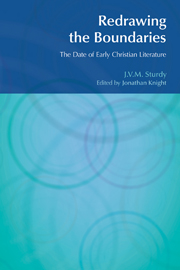Book contents
- Frontmatter
- Contents
- Preface
- Abbreviations
- 1 The Problem Posed
- 2 1 Clement
- 3 The Letters of Ignatius
- 4 Polycarp
- 5 Early Christian Literature: Some Parameters of Date
- 6 The Relationship of the Synoptic Gospels
- 7 Mark
- 8 Luke
- 9 Matthew
- 10 Acts
- 11 The Pauline Corpus: Its Growth and Development
- 12 The Catholic Epistles
- 13 Johannine Literature
- 14 Summary and Conclusions
- Appendix
- Notes
- Bibliography
- Index of Names
- Index of References
7 - Mark
- Frontmatter
- Contents
- Preface
- Abbreviations
- 1 The Problem Posed
- 2 1 Clement
- 3 The Letters of Ignatius
- 4 Polycarp
- 5 Early Christian Literature: Some Parameters of Date
- 6 The Relationship of the Synoptic Gospels
- 7 Mark
- 8 Luke
- 9 Matthew
- 10 Acts
- 11 The Pauline Corpus: Its Growth and Development
- 12 The Catholic Epistles
- 13 Johannine Literature
- 14 Summary and Conclusions
- Appendix
- Notes
- Bibliography
- Index of Names
- Index of References
Summary
We have seen the general scope of opinion is that Mark was written between 65 and 75 CE. In my view, it was written nearer to 80 than to 65 CE. I think that, despite this, it was still the first Gospel to be written. There is in any event a strong presumption that Mark was not written before 70 CE for the reasons I will explain in this chapter.
Mark's Gospel was not written by the person called John Mark, the son of Mary and the companion of Barnabas and Saul (Acts 12:12; 12:25; 13:5, 13; 15:37, 39). The Gospel is in fact anonymous. This point is accepted by a whole tradition of reputable scholarship. With the rejection of this supposed but fictitious authorship, the case for dating Mark later rather than earlier gains ground.
Mark 16:9-20 is generally, and in my view rightly, denied to the original Mark. It is a secondary addition whose terminus ad quem is the second quarter of the second century.
A Post-70 Date
Mark has generally been dated either just before or after the fall of Jerusalem (70 CE). With the appearance of Hooker's commentary, there is now an increasing move towards acceptance of the later date. I certainly agree that Mark was not written before 70 CE. I want to argue that it should be placed just a little later still. My case for this later date begins with a consideration of Mark 13. This part of the Gospel is generally called the “Synoptic Eschatological Discourse”.
- Type
- Chapter
- Information
- Redrawing the BoundariesThe Date of Early Christian Literature, pp. 35 - 41Publisher: Acumen PublishingPrint publication year: 2008

